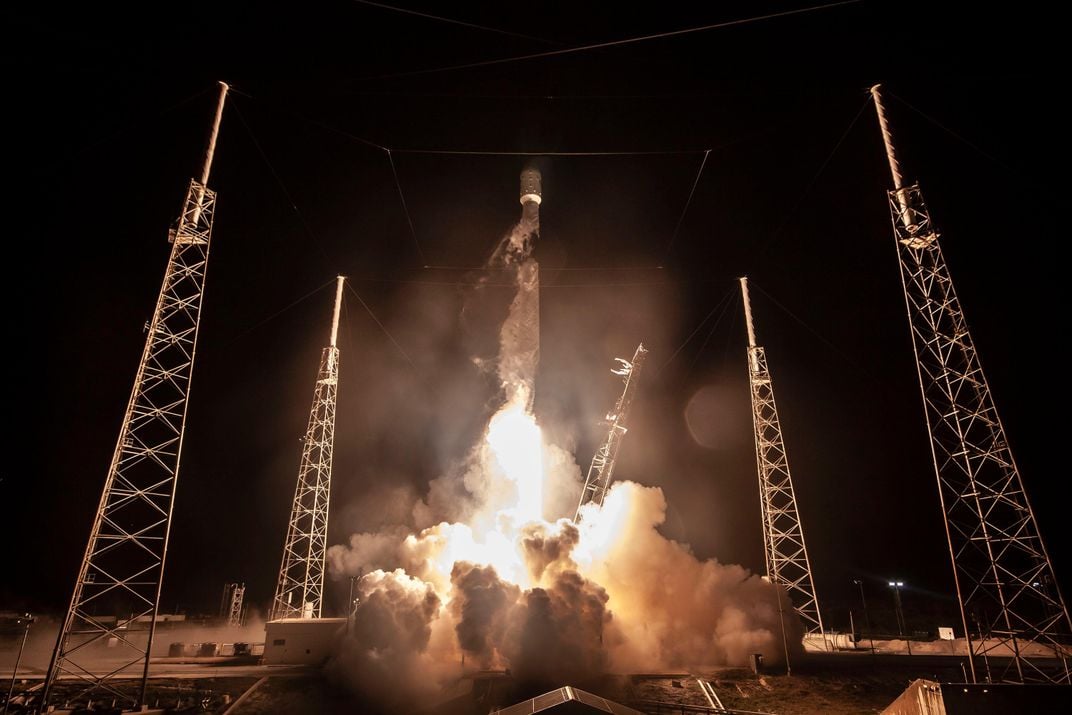Israel’s Private Lunar Lander Blasts Off for the Moon
The Israeli spacecraft Beresheet will gradually raise its orbit to reach the moon, landing after about a month and a half of flight
/https://tf-cmsv2-smithsonianmag-media.s3.amazonaws.com/filer/ec/ba/ecbaac98-98c3-4e23-83bb-8bd5dc16b8d1/real_spacecraft_on_the_moon_-_spaceil.jpg)
On Thursday evening, SpaceX launched its first rocket of the year from Cape Canaveral, and tucked inside was the first lunar lander built with mostly private money. The robotic lander, dubbed Beresheet (which means “Genesis” or “in the beginning” in Hebrew) lifted off at 8:45 pm EST on top of a Falcon 9 rocket. If all goes according to plan, Beresheet will gently touch down on the lunar surface on April 11, becoming the first private spacecraft to reach the surface of another planetary body.
To date, only three nations have landed on the moon: the United States, Russia and China. If this mission succeeds, Israel will become the fourth—and by far the smallest—country to reach the lunar surface.
The robotic lander is the brainchild of SpaceIL, an Israeli non-profit and Google Lunar X Prize finalist. The X Prize was an international contest founded to challenge private companies to build spacecraft capable of landing on the moon without government funds. However, the competition was canceled in January 2018 when it became clear that none of the contestants would reach the moon by the specified deadline.
But that didn’t stop SpaceIL. The company continued to develop the lander that’s currently en route to the moon. Beresheet—which is roughly the size of a washing machine—will beam back images of the lunar surface and carry out measurements of the lunar magnetic field. Before it can complete its mission, however, the little lander must survive an arduous four-million-mile, seven-week journey through space.

Beresheet cannot fly directly to the moon, SpaceIL officials have said. The lander shared a ride with two other payloads. (An Indonesian communications satellite and a small payload for the U.S. Air Force were also nestled inside the Falcon 9’s payload fairing.) "We knew we didn’t have a Saturn V [to get to the moon], so we’re using SpaceX,” Yigal Harel, head of SpaceIL’s spacecraft program, said during a pre-launch news conference on Wednesday night. And SpaceX’s flagship Falcon 9 rocket has proven its capable of ferrying multiple satellites into space and depositing them in their appropriate orbits.
This rideshare-style space exploration was orchestrated by Spaceflight Industries, a company dedicated to ensuring smaller satellites can afford to book rides to space. But rideshares don’t always put the little sats into their optimal orbits.
"The problem with that is, it doesn't allow us to choose the orbit completely," says Yonathan Winetraub, one of the founders of SpaceIL. "We have to consider the requirements from the other payloads on the rocket.” And since SpaceIL was not the primary payload on this flight—Indonesia’s Nusantara Satu satellite, built by Maxar Technologies’ SSL, had priority—the team had to devise a clever path to get to the moon.
The spacecraft will slingshot around Earth for about six weeks, firing thrusters to stretch out its orbit with every pass until it can be captured by the moon’s gravity. The landing sequence is a fully autonomous process, unlike the craft’s journey to space, where the team can adjust the craft’s trajectory if necessary. According to Harel, the landing process should take about 20 minutes and end with Beresheet touching down on the moon's near side, in a region called Mare Serenitatis, or the “Sea of Serenity”—near the landing sight of Apollo 17, the last lunar landing mission to launch from Cape Canaveral.
But before it can land, Beresheet must make it to the moon, and its six-week jaunt around the Earth may seem like an odd approach. After all, the Apollo missions flew directly to the moon, landing less than a week after launch. More recently, China's Chang'e-4 spacecraft reached lunar orbit a few days after launch.
The SpaceIL strategy of gradually raising Beresheet’s orbit around Earth, however, helps to keep the lander’s price tag low. The entire mission cost about $100 million—quite inexpensive for a lunar mission. However, the low price tag comes with some drawbacks. Beresheet is only expected to survive on the lunar surface for about two or three days. Temperatures on the moon are extreme, with the daytime heat reaching about 100 degrees Celsius and the nighttime chills dipping to minus 173 degrees, and the budget lander isn’t equipped to deal with the sweltering heat of a lunar day.
But it will have just enough time to carry out its primary objectives: plant an Israeli flag on the moon, measure the moon's magnetic field, study surrounding lunar craters, and of course, take some epic lunar selfies. SpaceIL officials say that the data collected will help scientists learn more about the creation and evolution of the moon.
Under the original terms of the Google Lunar X Prize contest, Beresheet would have been required to fire thrusters and hop to a new location at least 500 meters away from the landing site. On Wednesday evening, SpaceIL officials said that they hadn’t decided if they will attempt the risky hop or not and would decide based on how the lander performs in flight.
Simply making it to the moon, however, would be a historic achievement, as Beresheet would be the first non-government craft to reach the lunar surface. With SpaceIL’s success, we could see more private companies venture beyond Earth orbit. Up to this point, the moon has been a destination that only wealthy and powerful nations could reach. But as the cost of access to space continues to plummet, the moon may soon become a regular destination.

